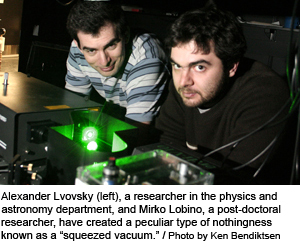Physics breakthrough much ado about “nothing”
By Grady Semmens
Two research teams, including one from the University of
Calgary, have independently proven it’s possible to
store a special kind of vacuum in a puff of gas and then
retrieve it a split second later.
 In our everyday life, light is completely gone when we turn
it off. In the world of quantum physics, which governs microscopic
particles, even the light that is turned off exhibits some
noise. This noise brings about uncertainty that can cause
trouble when trying to make extremely precise measurements. In our everyday life, light is completely gone when we turn
it off. In the world of quantum physics, which governs microscopic
particles, even the light that is turned off exhibits some
noise. This noise brings about uncertainty that can cause
trouble when trying to make extremely precise measurements.
Using crystals to manipulate laser light, researchers create
a peculiar type of nothingness known as a “squeezed
vacuum,” which under certain conditions, exhibits less
noise than no light at all. A squeezed vacuum is employed
in gravitation wave detection; it is also important in the
booming field of quantum information technology, where it
is used to carry information and to generate an even more
mysterious quantum object, entangled light.
Building on the 2001 breakthrough of Harvard-Smithsonian
scientists who slowed light down to a stop, teams of physicists
from the U of C and the Tokyo Institute of Technology have
independently demonstrated that a squeezed vacuum can be
stored for some time in a collection of rubidium atoms and
retrieved when needed. In work to be published in the March
7 advanced online edition of the leading physics journal
Physical Review Letters, the physicists measured the noise
of the retrieved light and found it to remain “squeezed” compared
to no light at all.
“Memory for light has been a big challenge in physics
for many years and I am very pleased we have been able to
bring it one step further,” said Alexander Lvovsky,
professor in the Department of Physics and Astronomy, Canada
Research Chair and leader of the U of C’s Quantum Information
Technology research group. “It’s important not
only for quantum computers, but may also provide new ways
to make unbreakable codes for transmitting sensitive information”.
"I'm very impressed," physicist Alexander Kuzmich
of the Georgia Institute of Technology in Atlanta told the
American Association for the Advancement of Science’s
ScienceNOW news service of the squeezed vacuum discovery.
Kuzmich, who was able to store and retrieve a single photon
in 2006, said the development could help create new types
of quantum networks for ultra-secure information transmission
and help spell out the boundary of the quantum realm. "It's
a real technical achievement," he said.
Lvovsky’s team is continuing work on light storage
and is now investigating the possibility of storing more
complex forms of quantum light, such as entangled light,
which has a wide range of applications for quantum computing
and information exchange.
For more information:
See story on ScienceNOW website: http://sciencenow.sciencemag.org/cgi/content/full/2008/229/1
A
pre-press copy of Lvovsky et al’s paper “Quantum
memory for squeezed light” from the journal Physical
Review Letters can be obtained online at: http://arxiv.org/abs/0709.2258 |

